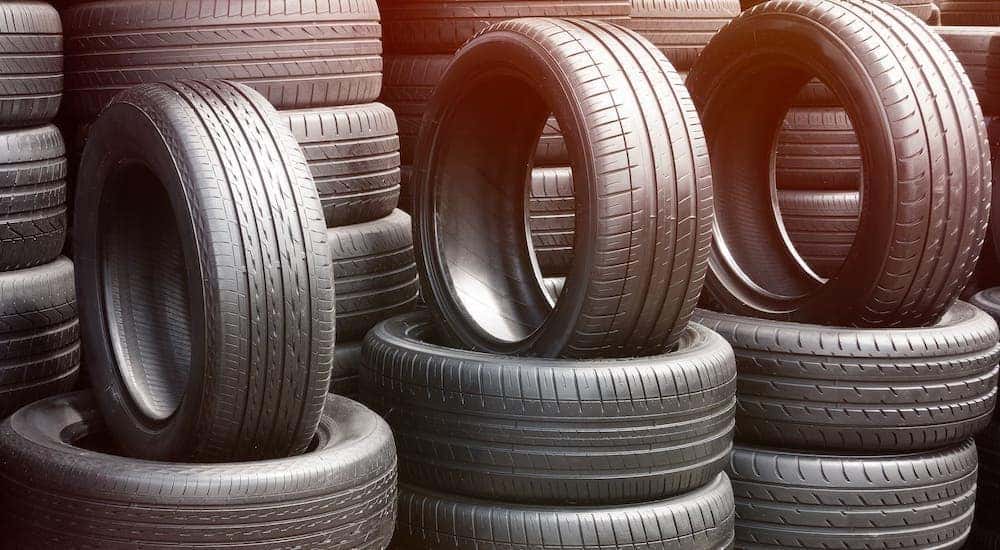The Science Behind Tire Repair and Safety And Security
When it concerns the intricate world of tire upkeep and safety, there exists a world of science that commonly continues to be unseen by the average driver - morris tire. The products that make up a tire, the impact of tire stress on overall safety, the ramifications of tread wear, the detailed characteristics of tire traction, and the often-overlooked relevance of correct wheel placement all play important roles in ensuring an automobile operates safely and successfully. As we navigate through the intricacies of tire repair work and safety, it comes to be apparent that a much deeper understanding of these clinical concepts is not just advantageous yet essential for each motorist on the road
Tire Composition and Capability
What products comprise the composition of tires, and how do these components add to their capability when driving? Tires are complicated products, normally made from a combination of rubber compounds, textile, steel cables, and other chemical ingredients. One of the most usual kind of rubber used in tires is synthetic rubber, which uses resilience and resistance to use and tear. The textile layers, usually constructed from polyester, rayon, or nylon, offer toughness and stability to the tire framework. Steel cables are integrated to improve the tire's strength and assist it preserve its form under different roadway conditions.
The structure of tires plays a vital function in their performance on the roadway - morris tire. The rubber substances provide grasp and grip, permitting the tire to adhere to the road surface area and provide security during acceleration, stopping, and cornering. The fabric and steel layers add to the tire's capacity to hold up against stress, keep its form, and support the car's weight. In general, the careful selection and combination of these materials make certain that tires can carry out efficiently and securely on numerous roadway surface areas and problems.
Effect of Tire Pressure on Safety
On the other hand, overinflated tires have less contact with the roadway surface area, decreasing grip and causing uneven wear on the tire footsteps. Correctly filled with air tires additionally play an important duty in fuel efficiency, as underinflated tires can boost moving resistance, leading to decreased gas mileage. Routinely checking and keeping the right tire pressure not only ensures security but likewise expands the life expectancy of the tires, saving on substitute costs in the long run.
Tread Put On and Its Ramifications
Appropriate tracking of tire walk wear is vital for ensuring optimum efficiency and safety and security when driving. As tires put on down, the depth of the tread decreases, decreasing the tire's capability to maintain traction, specifically in damp or unsafe problems. The tread pattern and deepness play an essential function in carrying water far from the tire to avoid hydroplaning and maintaining grasp on the roadway surface.
Irregular wear might suggest problems with tire positioning, inflation, or suspension parts. Use signs are developed right into the tire tread and come to be noticeable when the tread depth reaches a specific low point, showing the demand for immediate replacement.

Understanding Tire Traction Dynamics
Keeping track of tire walk wear not only makes sure ideal efficiency and security however also straight influences the grip characteristics of the tires on different roadway surface areas. Tire grip is a critical facet of automobile handling and safety and security, as it figures out the hold in between the tires and the roadway. Traction characteristics vary depending on road problems such as completely dry sidewalk, damp roadways, snow, or ice.

Comprehending tire grip dynamics is necessary for chauffeurs to adjust their driving behavior according to the road conditions. tire shop near me. On a regular basis examining tire tread depth and condition can significantly enhance grip efficiency, ensuring more secure driving experiences throughout different surfaces
Importance of Appropriate Wheel Positioning
Guaranteeing proper wheel placement plays a vital role in maximizing vehicle efficiency and expanding tire durability. Proper wheel placement includes readjusting the angles of the wheels to manufacturer requirements, making certain that they are perpendicular to the ground and alongside each various other. When placement is off, it can result in irregular tire wear, decreased fuel effectiveness, and jeopardized handling.
One of the crucial advantages of preserving correct wheel alignment is improved managing and stability. Misaligned wheels can cause the car to draw to one side, affecting guiding control and overall driving experience. Furthermore, correct placement promotes also tire wear, avoiding early tire substitute and minimizing upkeep prices over time.
%20(1).jpg)
Final Thought
In final thought, the scientific research behind tire fixing and safety is important for keeping lorry performance and ensuring chauffeur security. By understanding tire composition, stress, tread wear, grip dynamics, and wheel placement, chauffeurs can prevent accidents and prolong the life expectancy of their tires. Appropriate maintenance and regular inspections are vital for optimal tire efficiency and overall car safety. By complying with these guidelines, vehicle drivers can drive with confidence knowing that their tires are in great problem.
The products that compose a tire, the influence of tire stress on total safety, the implications of step wear, the detailed characteristics of tire grip, and the often-overlooked value of appropriate wheel alignment all play essential functions in guaranteeing an automobile operates safely and successfully. On the other hand, overinflated tires have less contact with the roadway surface area, lowering grip and triggering unequal wear on the tire footsteps. Frequently inspecting and maintaining the right tire pressure not just guarantees security yet also expands the life-span of the tires, conserving click to read more on substitute prices in the long run.
Checking tire tread wear not only makes certain optimum efficiency and safety and security yet additionally straight affects the grip characteristics of the tires on different roadway surface areas. Tire grip is a critical aspect of car handling and security, as it identifies the grip between the tires and the road.